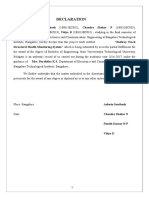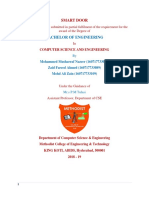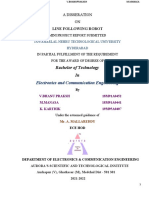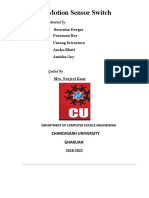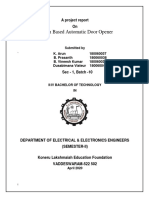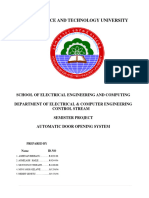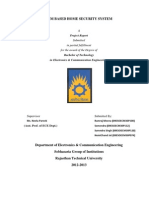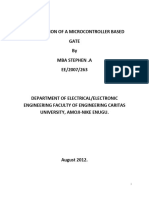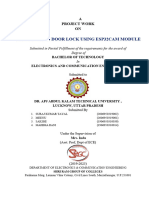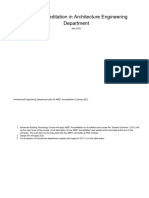NATIONAL CERTIFICATE IN INSTRUMENTATION AND CONTROL SYSTEMS
ELECTRICAL ENGINEERING DEPARTMENT
MOTION BASED AUTOMATED DOOR SYSTEM
BY CHAPANANGA GRACE T
SUPERVISOR
MS. M MASHORA
A PROJECT PROPOSAL SUBMITTED TO GWERU POLYTECHNIC IN
FULFILLMENT OF THE REQUIREMENTS OF THE NATIONAL CERTIFICATE
IN INSTRUMENTATION AND CONTROL SYSTEMS ELECTRICAL
ENGINEERING.
2024
1
�DECLARATION
I hereby declare that the project work entitled “Motion based automated sensor door system”
submitted to the Gweru polytechnic is a record of original work done by me under the
guidance of Ms. M Mashora, Lecture in charge of the electronics engineering and this project
work is submitted in partial fulfillment of the requirements for the award of the national
certificate in Instrumentation and control systems. The results embodied in this thesis have
not been submitted to any other Institute for the award of any certificate or diploma.
2
�APPROVAL FORM
The undersigned certify that they have read and recommend to the Gweru Polytechnic for
acceptance; a project entitled, Design and Implementation of Motion based automated sensor
door system by Grace Chapananga in fulfillment of the requirements of the National
Certificate in Instrumentation and Control System.
……………………………… ……………………………….
SUPERVISOR DATE
3
�ACKNOWLEDGEMENTS
I would like to acknowledgements my tutors and my supervisor Ms. M Mashora for the
unwavering support they offered to me to produce this piece of work. I also acknowledge the
normal support offered by my family and pastor who have been encouraging me during the
process of research. Fellow students who offered critical views on the research are not taken
for granted including the authors of the books I have used. Foremost, I would like to give
glory to the Lord Jesus, who enabled me to author and research on creating this motion based
automated sensor door system.
4
�ABSTRACT
To reduce the difficulty and unnecessary delay experienced by physically challenged and
elderly people when entering or exiting a facility through a door, a motion based sensor door
system was implemented. The motion based automated sensor door system utilizes advance
motion detection technology to automatically open and close doors. This innovative system
enhances accessibility, minimizes human interaction and optimizes energy consumption.
Advanced proximity sensors detect human motion within a specified range, triggering
automated door opening. The command for the door to open is sent when the ultrasonic
sensor used in the project detects any human movement. The door then automatically closes
after a specific time delay if there is no further motion near the sensor. There is reduced
energy consumption by automatically closing doors when not in use. Intuitive interface for
easy installation, configuration and maintenance. Proximity sensors (ultrasonic sensor) are
used for to detect motion, whilst motorized system is used for automated door movement. A
power supply of 5V is being used for efficient operation.
5
�Table of contents
Declaration…………………………………………………………………………………..2
Approval Form……………………………………………………………………………...3
Acknowledgement…………………………………………………………………………..4
Abstract……………………………………………………………………………………...5
Chapter I..................................................................................................................................... 8
1.1 Introduction. ................................................................................................................ 8
1.2 Background of story. ................................................................................................... 8
1.3 Statement of problem .................................................................................................. 8
1.4 Aim of the study .......................................................................................................... 8
1.5 Objectives. ................................................................................................................... 8
1.6 Justification ................................................................................................................. 9
1.7 Scope of the study ....................................................................................................... 9
1.8 Limitations .................................................................................................................. 9
1.9 Delimitation................................................................................................................. 9
1.10 Conclusion................................................................................................................... 9
1.11 Work plan .................................................................................................................. 10
Chapter II ................................................................................................................................. 11
2.1 Introduction ........................................................................................................... 11
2.2 Analysis of study ................................................................................................... 11
2.3 Gaps identified ....................................................................................................... 12
2.4 Conclusion ............................................................................................................. 12
Chapter III ................................................................................................................................ 13
3.1 Introduction ........................................................................................................ 13
3.2 Methods.............................................................................................................. 13
3.3 Components description..................................................................................... 13
3.3.1 Ultrasonic Sensor as Sensing Unit .......................................................... 13
3.3.2 Arduino Uno as a Processing unit.......................................................... 14
3.3.3 Relay as Controlling Unit ....................................................................... 15
6
� 3.3.4 Software Used ......................................................................................... 16
3.3.5 Electric laser lens as the door ................................................................. 17
3.4 Conclusion ......................................................................................................... 18
Chapter IV ................................................................................................................................ 19
4.1 Introduction .................................................................................................... 19
4.2 Testing and results .......................................................................................... 19
4.3 Analysis of the prototype per each case ......................................................... 19
4.4 Conclusion...................................................................................................... 20
Chapter V ................................................................................................................................. 21
5.1 Introduction ................................................................................................ 21
5.2 Challenges .................................................................................................. 21
5.3 Future works ............................................................................................... 21
5.4 Recommendations ...................................................................................... 21
5.5 Conclusion .................................................................................................. 22
5.6 References .................................................................................................. 23
7
�Chapter I
1.1 Introduction.
This project proposes the design and development of a motion-based automated sensor door
system which will improve accessibility and user experience on a hospital main entrance
door. The system will utilize sensors to detect motion and automatically open and close
doors, eliminating the need for manual operation.
1.2 Background of story.
Automatic door system have been in use for several decades. However these early systems
had limitations such as high cost, complex installation and maintenance issues. These factors
make them inaccessible to some users. The proposed motion based sensor door system aims
to address these limitations by using advanced sensor technology and motor control to
provide a cost effective, easy to install and customizable solution.
1.3 Statement of problem
Manual door operation can be a challenge for individuals with disabilities, elderly and even
able bodied individuals with hands full of medication or pushing stretcher beds. Existing
automatic door systems have limitations such as high cost, complex installations and
maintenance issues. The existing automatic door system consume high amounts of power
leading to increased energy costs. Automatic door systems can be slow or unreliable leading
to user frustration.
1.4 Aim of the study
The aim of this project is to design a cost effective, easy to install and maintenance friendly
motion based automated sensor door system.
1.5 Objectives.
To design and make a prototype of a motion based sensor door that automatically
opens and closes doors
To improve accessibility and user experience for individuals with disabilities and
others
To improve energy efficiency
To test and evaluate the results obtained when testing the prototype
8
�1.6 Justification
The proposed motion based sensor door will be fixed on a hospital main entrance door there
it will reduce energy consumption and minimize the need for manual intervention resulting in
significant cost savings for the organisation. The system will provide easy and convenient
access for patients especially those with mobility issues and reduce touch points thereby
minimising risk of contamination from manual door handles.
1.7 Scope of the study
The project will focus on Literature review of existing automatic systems, the designing and
development of motion based sensor system and prototype testing, evaluating and
recommendations.
1.8 Limitations
The lack of financial income constraints the outcome of the proposed project. Because of
unavailability of some material the proposed project was affected when making the
prototype. Limited time to proper research and review was an obstruct in the generation of
the project. The ultrasonic sensor that l used for the prototype making has reduced detection
range in extreme temperatures and it also has false triggers from animals or environmental
changes.
1.9 Delimitation
The project proposed will be placed in a hospital in the emergency unit (ICU). This will help
the patients with critical conditions.
1.10 Conclusion
The proposed project aim to design and develop an innovative automated sensor motion door
prototype that address the limitations of the existing systems. The successful completion of
this project will contribute to development in the ICU technologies and enhance user
experience.
9
�1.11 Work plan
project proposal literature review
methology design implementation and testing
result recommentation and conclusion final document submission
prototype presentation
10
�Chapter II
2.1 Introduction
Automated motion door sensors have become increasingly popular in recent years due to
their convenience and efficiency in detecting movement and opening doors automatically.
This literature review aims to analyse existing studies on automated motion door sensors and
identify any gaps in the research that could be addressed in the proposed project.
2.2 Analysis of study
Several studies have been conducted on automated motion door sensors focusing on their
effectiveness on various settings such as homes, offices, public toilets and hospitals. Smith et
al (2018) conducted a study on the use of automated motion door sensors in hospitals
mentioning that it improves accessibility for patients with mobility issues. The study found
that the sensors were successful in reducing the need for manual door thereby improving the
overall efficiency of the hospital but there was also a constrain in the money needed to
purchase the sensors. A large number of hospitals could not afford the sensors thereby
limiting the number of hospitals this door was to be used.
In contrast Jones et al (2019) conducted a study on the use of automated motion sensors in
office buildings and found that while the sensors were effective in detecting movement and
opening there are issues with the sensitivity adjustments and false alarms. This highlights the
importance of considering the specific needs and requirements of different settings when
implementing automated motion door sensors. Brown and Wilson (2018) conducted a case
study on the effectiveness of automated motion based doors in public transportation hubs, it
demonstrated cost savings by improving passenger flow and increasing security against
unauthorized entry. This system also showed disadvantages which include higher initial
installation costs and higher maintenance.
Anderson (2022) did an analysis of already existing motion based automated sensor door and
he came out with the following finds that the system responsiveness time in detecting motion
to activating the door mechanism is poor. Optimal responsiveness is crucial for smooth and
timely door operation. In his case study he also evaluated the advantages of using Arduino as
a microcontroller over discrete components. Implementing motion based doors using discrete
components requires a certain level of technical expertise. This might pose challenges for
installation, maintenance and troubleshooting. Adequate training and technical support would
11
�be necessary to overcome these challenges. Smith etal (2018) proposed a system which
operates with control of relays and with the use of WAGO PLC (Programmable Logic
Controller) and Arduino Uno. Switching operation of devices such as tube light, fan, AC, etc.
can be operated spontaneously by using ultrasonic sensor and on the basis of environmental
conditions. In real-time implementation, automatic control is done by sensor data and manual
control is done by android application. Difficulty in this project is the controlling and
monitoring of devices done by WAGO PLC and Arduino Uno both. These operations can be
done by using only Arduino Uno. Maslekar et al [2] proposed a smart door system in which
Raspberry Pi has used. Raspberry Pi is monitoring the motion of people. In the absence of a
person in the sensing range of the sensor the door is normally closed. The experimental
results of this system have shown that 50% energy is conserved but the difficulty is
Raspberry Pi is more expensive than Arduino Uno. Motion based doors can introduce
security concerns if not properly implemented. Unauthorized access of tampering with the
motion sensor could compromise the integrity of the system. It is essential to incorporate
appropriate security measures to mitigate such risks.
2.3 Gaps identified
Despite the existing research on automated motion door sensors there are several gaps that be
addressed in the proposed project. One key gap is the use of ultrasonic sensors in the project.
The use of this sensor will limit the cost needed to purchase sensor the motion sensor because
this sensor is relatively a bit cheaper than other sensors used before and it is readily available
on a number of electrical stores. This type of sensor also has a wide distance range of
detecting motion compared to other sensors. The arduino used will consume less power
which is beneficial for battery powered systems.
2.4 Conclusion
In a nutshell, automated motion sensor door have the potential to revolutionize the way we
interact with doors in various settings. By addressing the gaps identified in the existing
research, the proposed project will contribute to the development of more advanced and
sustainable automated door systems. Future studies should focus on the integration of
automated motion sensor door with other smart technologies and the impact of these sensors
on energy consumption and sustainability.
12
� Chapter III
3.1 Introduction
Motion-based sensor door research involves investigating and developing technologies that
enable doors to automatically open, close, or adjust based on detecting human motion or
presence. For this research I studied existing motion sensing technologies, door automation
systems and their applications online from academic papers, journals and industrial reports.
Information was gathered from journals on intelligent buildings, and research studies such as
the design and implementation of an automated door system using motion sensors" (2020), a
study on the performance of motion sensors in automated doors" (2019), investigation of
motion sensor technologies for automated doors (2019) and comparative study of automated
door systems using different motion sensors (2018). These studies and journals provide
valuable insights into the design, functionality, user experience, and performance of motion-
based automated sense doors, as well as the latest advancements and trends in the field.
3.2 Methods
Literature review- Initial research was conducted to gather information on existing
automated sensor system focusing on the components used, the efficiency and sensor
accuracy.
Testing and Validation- After assembly extensive testing was conducted to ensure
that the automated door system was operating as intended and met all the
requirements and objectives.
3.3 Components description
The automated motion sensor door system consists of different hardware components that can
be used for sensing, processing and controlling of appliances. These hardware components
are discussed below:
3.3.1 Ultrasonic Sensor as Sensing Unit
The sensing unit is used to get input parameters from surrounding which is required for
automation. For particular area of room, the following points must be kept in mind to perform
operation in good order: Continuous changes in human motion
Here, the sensing unit used is ultrasonic sensor which is as shown in given in Figure
3.3.1
13
� Figure 3.3.1 ultrasonic sensor
The working of ultrasonic sensor is to detect the motion of a person when person comes in
the sensing range of the sensor. The specialty of this sensor is it is little, affordable, low
power, easy to use and do not exhaust. Hence, this sensor is used in many home automation
appiances.
3.3.2 Arduino Uno as a Processing unit
Arduino Uno is a microcontroller in which ATmega328 microprocessor is used which is
shown in the Figure 3.3.2
14
� It has 6 analog input pins and 14 digital input or output pins which can be used as PWM
(Pulse Width Modulation) outputs. It has its own programming language. The crystal
oscillator frequency of this microcontroller is 16MHz. It has USB cable which can simply
connect with computer, power barrel jack, reset button and ICSP (In Circuit Serial
Programming). Each pin of the Arduino Uno is operated at 5V.The programming language of
this microcontroller is not complex.
3.3.3 Relay as Controlling Unit
A relay is a digital switch that controls much higher currents and voltages. This device is
widely used in power protection. The benefits of this device are small in size, stability and
long-time reliable and it can be also used for both ac and dc systems. Relay has three
terminals that are normally closed terminal, normally open terminal and common terminal. It
has three pins GND, VCC and input signal.
15
� Figure 3.3.3 Relay Module
3.3.4 Software Used
Software used to control this system is Arduino IDE (Integrated Development Environment).
This software is used to write the program and compile it to the Arduino Uno board.
Therefore, the arduino software commands control the arduino board, sensing devices and
another circuitry.
const int pirPin = 13;
const int relay1Pin = 2;
const int relay2Pin = 3;
const int openDelay = 1050;
const int closeDelay = 5000;
void setup() {
pinMode(pirPin, INPUT);
pinMode(relay1Pin, OUTPUT);
pinMode(relay2Pin, OUTPUT);
Serial.begin(9600);
}
void loop() {
int sensorVal = digitalRead(pirPin);
16
� if (sensorVal == LOW) {
Serial.println("Motion detected!");
// Open the door
digitalWrite(relay1Pin, HIGH);
digitalWrite(relay2Pin, LOW);
delay(openDelay);
// Stop the motor
digitalWrite(relay1Pin, LOW);
digitalWrite(relay2Pin, LOW);
delay(closeDelay);
digitalWrite(relay1Pin, LOW);
digitalWrite(relay2Pin, HIGH);
delay(openDelay);
digitalWrite(relay1Pin, LOW);
digitalWrite(relay2Pin, LOW);
delay(closeDelay);
}
}
3.3.5 Electric laser lens as the door
The electric laser lens represents the door system being controlled. The electric laser lens is
the end device being controlled by the Arduino through the relay based on signals from the
ultrasonic sensor.
17
�Figure 3.3.4
3.4 Conclusion
The research methodology and tools employed in this project provide a comprehensive
approach to developing an automated motion sensor door system using Arduino Uno and
ultrasonic sensor.
18
�Chapter IV
4.1 Introduction
This chapter provides a detailed testing results and analysed findings per each case of the
prototype. It starts by showing the analysis of the findings per each case.
4.2 Testing and results
From the result of the test on the system it was discovered that the aim of this project was
successful. The prototype made was able to detect motion , opened the door and closed after a
time delay.
4.3 Analysis of the prototype per each case
The components used in this circuit are ultrasonic sensor, electric laser lens motor, relay and
LED. Vcc pin of ultrasonic sensor and servo is connected to the positive terminal of the
power supply with 3.3V and 5V respectively, ground pins are connected to the ground of
Arduino, the output pin of ultrasonic sensor is connected to digital port 2 of the arduino.
Fig 4.3.1
19
�Fig 4.3.2
Fig 4.3.1 No motion is being detected by the sensor hence the door is closed and no working.
Fig 4.3.2 Motion has been detected by the sensor hence the door is open and working.
4.4 Conclusion
This chapter presented the results obtained from testing the Motion based automated sensor
door system prototype demonstrating its effectiveness in providing a convenient and efficient
operation solution. The findings show that the system successfully detected motion, opened
and closed the door automatically with a response time delay of ±12s to close the door.
20
�Chapter V
5.1 Introduction
This last chapter with for see the overview of the whole write up giving challenges faced
when producing this project, the future works that can be implemented to the project,
recommendations and the write up final conclusion.
5.2 Challenges
Time – Completing the project within the allocated timeframe was challenging due to
the complexity of integrating multiple components and technologies.
Components related – Choosing the suitable sensor with high accuracy, reliability and
compatibility with the microcontroller was challenging. Also Gweru has a few
electrical shops that sale these components that made my choices limited in the
components I used in the project.
Cost constraints – This project did not have any funds that helped in the buying of the
components, researching and printing of this document I solely sponsored everything
using my own funds. So I was working on a limited budget.
Researching – For this project l had to rely on most of the information l got on the
internet there was not a book in our school library that had any information on the
project.
5.3 Future works
There can be a display unit for showing number of persons entered in a particular
room. A better sensor is recommended to achieve new functionality. For instance a
suitable sensor such as radar sensor that could contraband goods any person is
carrying. Investigate alternative sensor technologies for improved detection accuracy.
Can be further used in security systems by implementing biometric authentication
and also develop a mobile monitoring and system configuration.
Upgrading the system using higher bit microprocessors for speed optimization.
5.4 Recommendations
Based on the experiences gained in researching this project and making the prototype the
following recommendations are proposed:
21
� Focus on efficiency – Future prototypes should explore more efficient and accurate
sensors. Using a faster microcontroller will be an added advantage to the system.
User safety features – Implementing of biometrics and cameras to the system will
enhance the security of the door system.
Research – It is advisable to first gather up enough researches and questionnaires
before commencing this project.
5.5 Conclusion
In a nutshell a smart door system with motion detection capability has been created and
tested. The model produced results that were in line with the expectations. The objectives that
were set in chapter 1 of the project have been met. Thus, we can conclude that this is a simple
and low-cost architecture of automatic door opening system but having lots of benefits such
as we can conserve energy, reduces human efforts, saves time.
22
�5.6 References
Johnson,A, Smith,J, and Anderson L. (2022). Analysis of existing motion based automated
sensor door system. Journal of Engineering and Automation
Anderson,L, Davis ,M, and Thompson, E (2019). Infection Control benefits in Health
Settings. Journal of Infection Prevention
A. Maslekar, K. Aparna, K. Mamatha and T.Shivakumara, “Smart Door System using
Raspberry Pi”, International Journal of Innovative Research in Science and Technology,
Vol.4(7), 2015, pp.5113-5121I.
Vahid Hassanpour, Sedighe Rajabi, Zeinab Shayan, Zahra Hafezi, Mohammad Mehdi Arefi ,
“Low-Cost Home Automation Using Arduino and Modbus Protocol”, 5th International
Conference on Control, Instrumentation and Automation (ICCIA), Shiraz, 2017, pp. 284-289.
https://docs.arduino.cc/hardware/uno-rev3
https://docs.arduino.cc/learn/electronics/servo-motors
https://lastminuteengineers.com/servo-motor-arduino-tutorial/
tomatic%20Door%20Opening%20Closing%20System%20using%ultrasonic%20Sensor.pd
23


















